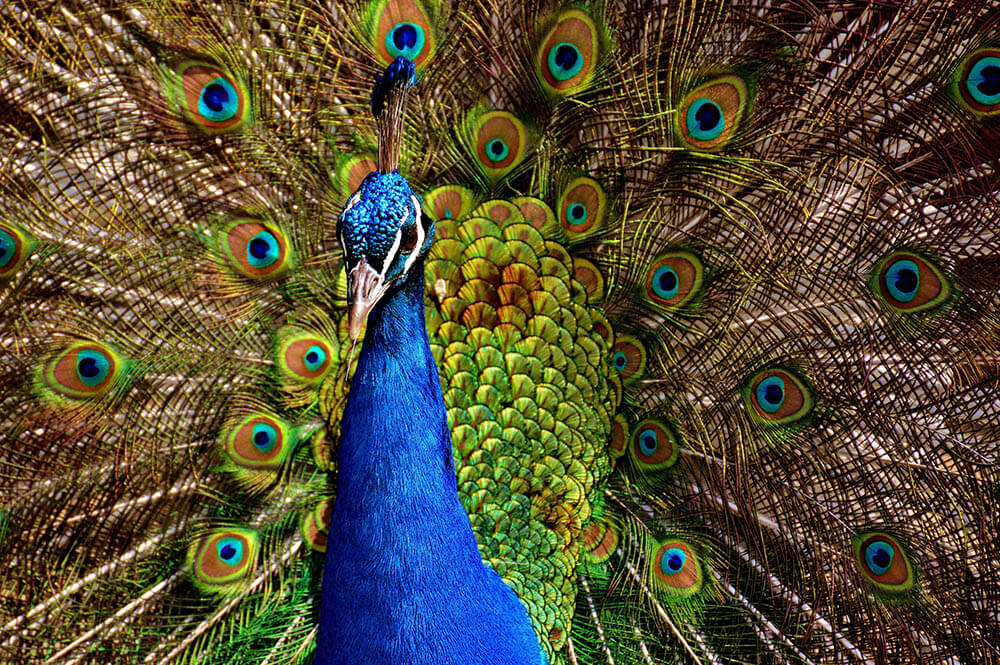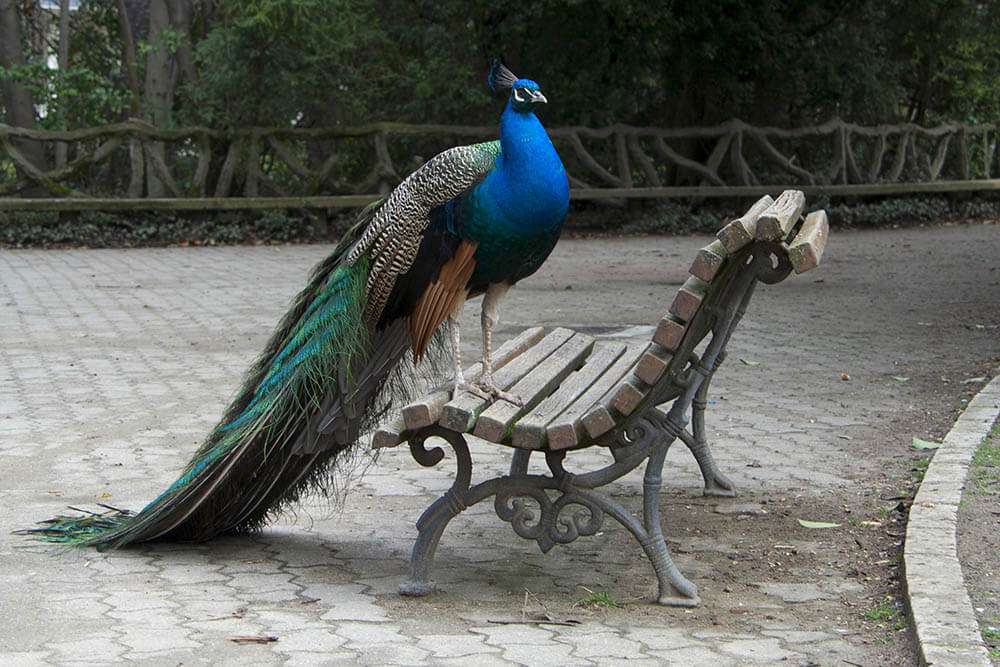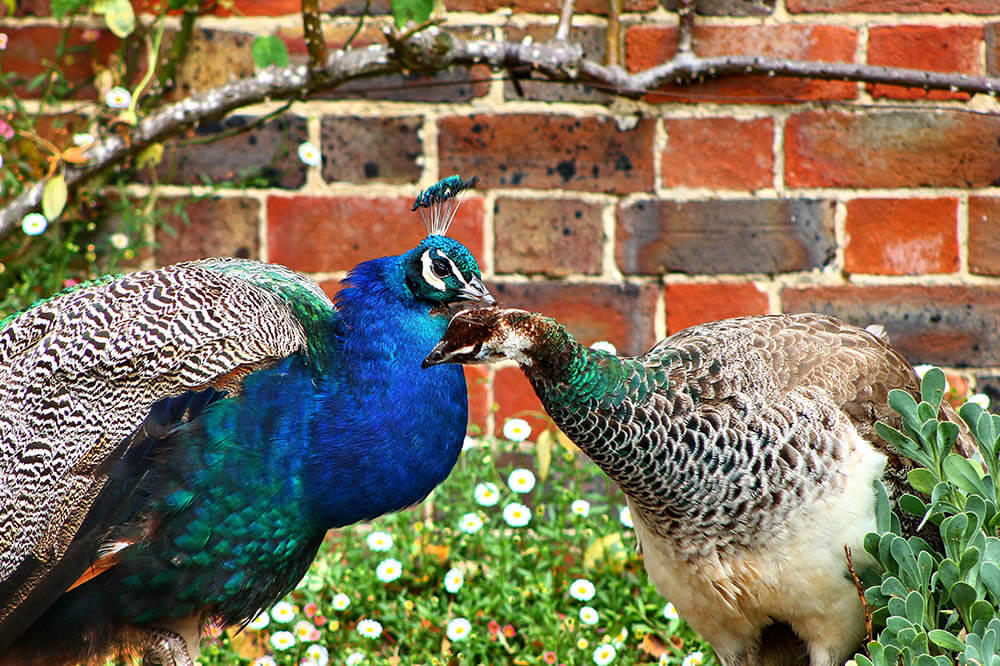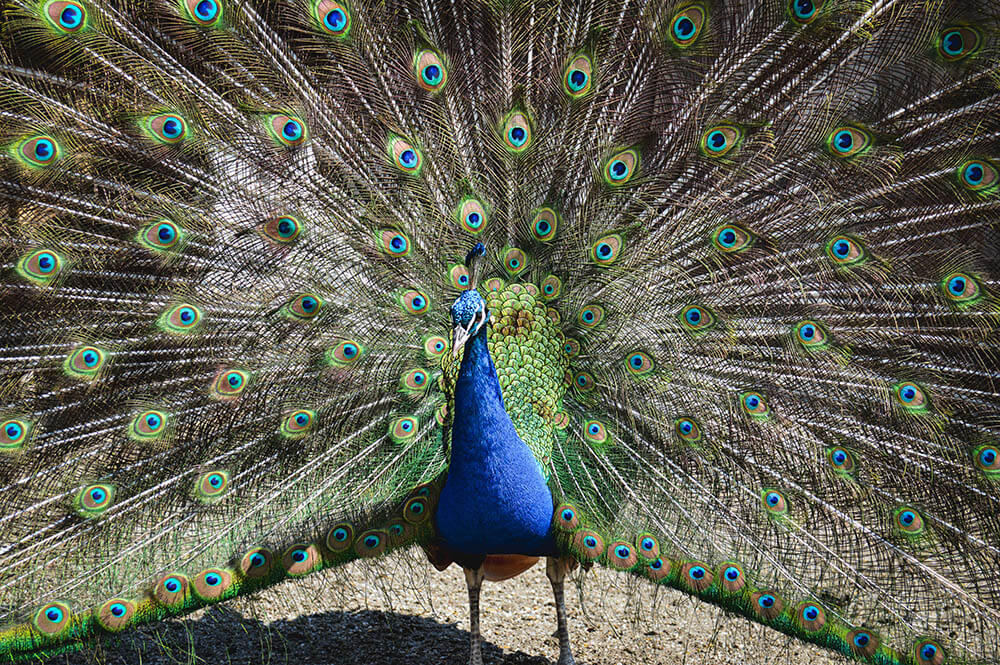Known for their regal colors and majestic feathers, peafowl are fascinating birds that captivate imaginations worldwide. In fact, this animal is so beloved that it became India’s national bird back in 1963.
Surely something so glamorous would have an equally beautiful personality? Surely it’s okay to hug a peafowl or even pluck one of its feathers to keep as a souvenir?
Unless you want a beak in your eye, we highly recommend not doing that.
The fact is, peacocks can be aggressive jerks. They’re known to chase and attack people, pets, and other animals, sometimes causing enough damage to draw blood. Attacks can be so vicious that some human victims develop a specific type of phobia called pavophobia – the irrational fear of peafowl. Given these birds’ tendency toward violence, however, we’d say it’s fair to argue there’s nothing irrational about fearing these birds.
But are peafowl actually dangerous? And why are they so aggressive? Read on to find out!
Note: while these birds are popularly known as “peacocks,” the proper, gender-neutral term for the species is “peafowl.” Peacocks are male peafowl, while peahens are female peafowl.

Are Peafowl Dangerous?
It depends on how you define the word “dangerous.”
Can a peafowl kill you? Probably not – though there is at least one instance of a peacock killing a full-grown human being. In this sense, no, peafowl aren’t dangerous.
But if what you mean by “dangerous” is “capable of causing you painful injury,” then yes, peafowl can be dangerous.
A peafowl may not have sharp teeth, but it does have a sharp beak and sharp talons. And when it assaults a creature it considers an enemy, it usually goes for the soft, vulnerable spots, like the eyes or the neck. Unless you want to risk getting blinded by this bird, we recommend not approaching one and making it angry.
Not to mention these birds are fairly large at around four feet tall, so they can be particularly dangerous where small children and pets are concerned. They can jump and fly, too, so even if you’re an adult, they can leap into the air and claw at your face. They’re also strong enough to push you down if they consider you a threat worth punishing.
There are many reports of peafowl attacking people, so there’s no denying these birds are aggressive. Attacks often occur in zoos, though they can also happen in urban and suburban areas and any other places where there are peafowl.
All that being said, peafowl aren’t predatory toward humans; they won’t hunt you down and kill you for food. They also won’t go out of their way to harass a large pet such as a dog or cat. In short, if you leave a peafowl alone, it’ll likely leave you alone, too.
So what causes a peafowl to act aggressively?

8 Reasons Why Peafowl Can Be Aggressive
Knowing why peafowl become aggressive can help you determine how to keep yourself safe from peafowl attacks. So let’s explore the various reasons behind peafowl aggression!
1. They’re wild animals
Don’t let their lovely looks fool you; peafowl aren’t friendly birds that’ll let you run your fingers over their feathers or pat them on the head. They’ll see these actions as an attack, which is of course a good reason for them to defend themselves by pecking you in the face.
Some zoos tame peafowl and let them walk around to the delight of visitors. Keep in mind, however, that these birds are wild animals that are still governed by their primal instincts, which means they won’t refrain from hurting you whether you threaten them unintentionally or not. For this reason, keep your hands to yourself when a peacock or peahen comes close to you at the zoo. If you have children, teach them to respect these birds, as they’re known to attack kids due to their tiny size.
Learn to be observant of peafowl body language. If one starts quickly strutting toward you, it’s likely not because it wants to say hello!
2. They aren’t friendly
Peafowl aren’t affectionate. With their difficulty co-existing peacefully with other birds, we can hardly call them social. In fact, it’s quite common for peacocks to viciously attack other peacocks. So although they do tend to live in groups, those groups can be full of strife and misery.
If peafowl aren’t friendly toward others of their kind, why should we expect them to treat us any differently?
True, some peafowl do become affectionate toward humans and even develop bonds with them. Most, however, remain standoffish, suspicious, and ready to poke you in the eye the moment you annoy them.
3. They’re territorial
Like many birds, peafowl are territorial. They take immense pride in their space and treat their ownership of it with extreme seriousness. Any creature that enters this area is immediately interpreted as an invader, spurring a peafowl to defend it using violence. Don’t want to get hurt? Then don’t walk into a peafowl’s territory.
But what if you have a pet peafowl that you have to feed? If you don’t want it pecking you to death, always approach its territory slowly. Don’t make loud noises or sudden movements, either; these creatures startle easily, which may immediately provoke an attack. The moment you observe any signs of aggression or stress, move away and allow the bird to calm down. Only try approaching it again once it becomes more accepting of your presence.
Keep the above advice in mind and make sure to respect a peafowl and its space!
4. It’s mating season
Dating may be tough for us humans, but it’s even more difficult for peafowl.
During mating season, peacocks experience a surge in hormones that make them highly irritable. It doesn’t help that they have to work harder to look extra fabulous; after all, they have to compete against other males to impress a lovely peahen to mate with. All this stress makes peacocks exceptionally ill-tempered during this time.
When a peacock has found a mate or several, he can also grow extremely possessive. If a second peacock enters his space, he could become convinced that this other male is trying to steal his mate(s), so he becomes violent to defend his possessions. Of course, being a fairly unintelligent critter, a peacock could also mistake another species’ intentions and attack you for the same reason.
Peahens are just as likely to act aggressively. They’re preparing nests and hoping to lay eggs, so they’re not exactly in the mood to be disturbed by you or other animals.
For all these reasons, stay away from peafowl during their mating season. Would you like it if someone interfered with you while you were trying to impress someone you’re interested in?

5. They’re protective of their eggs
One of the main reasons why peacocks and peahens are so territorial is they want to protect their eggs.
A peahen doesn’t lay many eggs throughout her life. It isn’t until her fifth year that she starts laying between five and nine eggs per year. If those eggs are taken away from her, she may lay one or two more clutches, though she’ll only be able to incubate around ten more eggs.
It’s therefore important for peafowl to keep their nests safe from animals that would steal and eat their eggs. If you approach their territory, both the male and the female could see this as your attempt to take those eggs, prompting them to fight you off using their beaks and talons. This is why it’s especially crucial to steer clear of peacocks and peahens when they have eggs.
6. They’re not too bright
Peafowl aren’t the smartest of birds, which makes it challenging for them to discern between friend and foe. This is why they can mistake a harmless human for a predator who’s trying to kill them for their meat or make off with their eggs.
In urban areas, these creatures are even known to attack luxury cars sporting dark colors. Why? They convince themselves their reflection on the car is another bird they need to defend themselves from!
7. They’re hungry
When a captive peafowl is hungry, it needs a way to tell its keeper that it wants to be fed. Unfortunately, these birds don’t have many ways to express themselves in a fashion that can be understood by humans. They therefore resort to the only method they know that produces results – behaving in an aggressive, potentially harmful way.
Avoid being subjected to this kind of abuse – don’t get a peacock pet! Let the experts at zoos and wildlife sanctuaries handle these cantankerous birds!
8. They want to steal your food
Peafowl are omnivores, which means they eat plant as well as animal matter. And they just so happen to have a food obsession. They love eating so much that if they smell a snack on you, they may chase you to steal your food. So if you’ve got a sandwich in your hand and there’s a peafowl coming toward you, consider going the other way.
They don’t just steal human food, however; in zoos, there are cases of these birds breaking out of their enclosures to steal other animals’ food.

Conclusion
It’s highly unlikely for a peafowl to kill you. But it can cut you with its sharp talons and pierce you with its beak. These creatures can become aggressive, ill-tempered creatures when irritated or threatened, so make sure you know what to do when you find one in your vicinity.
Avoid being on the receiving end of a peafowl assault: stay away from these birds and their territories, especially during mating season! And never try to pet one like you would a dog or cat!
